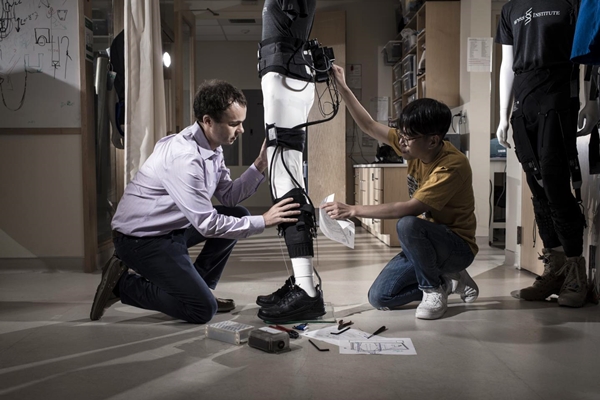
Conor Walsh, left, and graduate student Jaehyun Bae, with an ankle-supporting exosuit (Wyss Institute, Harvard University)
27 July 2017. A robotic device built and worn like clothing helps improve lower-limb walking performance for a group of people partially paralyzed with stroke. Results of this early test, conducted by engineering researchers at Harvard University and Boston University, appear in yesterday’s issue of the journal Science Translational Medicine.
A team from Harvard’s engineering school and Wyss Institute for Biologically Inspired Engineering, as well as Boston University’s Sargent College that studies rehabilitation, seeks to extend advances in exoskeletons to people with limited mobility, such as those with multiple sclerosis or recovering from a stroke. Exoskeletons are robotic devices with sensors and motors built on rigid lightweight frames worn like braces over the legs designed for people with full paralysis, such as those with spinal cord injuries. The devices provide some mobility by restoring a walking gait with stepping motions.
Individuals with limited mobility, however, present a more complex engineering challenge, since they already have some ability to walk, but still need assistance, usually provided today by a cane or braces. A different type of device is required that can sense the working joints and muscles, but also those needing assistance, and activate the motors for providing that assistance.
To meet that need, a research team led by Harvard engineering professor Conor Walsh, also on the Wyss Institute faculty, is developing a robotic device called an exosuit designed to be worn more like clothing. The exosuit blurs the line between apparel and robotics, where its fabrics are worn on the body to provide support and sense all muscular activity in the legs, yet are also designed to be comfortable.
Sensors in the exosuit react not only to movements by the wearer, but also tensions in the fabrics, which act as extensions of the robotic devices, with extra sensors and assistance provided to the ankle joint affecting many stroke patients. The exosuit’s actuator and control systems, worn on a belt at the waist, are also more sophisticated. The exosuit needs to detect and anticipate the intent of the wearer to provide added mobility to the limbs at the right time and with the amount of force required. At the same time, muscle movements not needing an assist remain unconstrained.
In the paper, the researchers tested a prototype exosuit with 9 participants in the chronic phase of stroke recovery, the time after hospitalization and intensive rehabilitation training when the individual usually needs to recover largely on his or her own. The participants, between the ages of 30 and 67, tested an exosuit device for 2 days on a treadmill, as well as walking over open spaces. The researchers looked for changes in participants’ ability to walk more symmetrically, i.e. less favoring of one leg over the other, and measures of energy needed to perform walking motions.
The results show the 9 participants were able to walk in more normal, symmetrical motions, with an average of 20 percent reduction in asymmetrical forward propulsion needed to push off with the ankle. The team also found a 10 percent reduction in the energy cost of walking, with nearly one-third less metabolic burden required. In addition, researchers found the most improvements made by individuals who started with the slowest walking speeds. Combined with other variations in performance, the researchers conclude exosuits need to be carefully integrated into rehabilitation plans customized for the individual patient’s condition.
As reported in Science & Enterprise in May 2016, ReWalk Robotics Ltd., an Israeli developer of exoskeletons, is licensing Harvard’s research on exosuits to develop an assistive device for people with limited mobility. Last month, a prototype exosuit system was introduced to the public.
The following video gives a demonstration of the device.
- Brain-Computer Device Tested with Consciousness Patients
- Computer Vision, Deep Learning Aid Prosthetic Hands
- Neural Technology Research Centers Launched
- Medical Robotics Company Crowdfunding IPO
- Neuro Device Company to Begin Clinical Trials in Europe
* * *

 RSS - Posts
RSS - Posts
[…] Exosuit Shown to Improve Walking for Stroke Patients […]